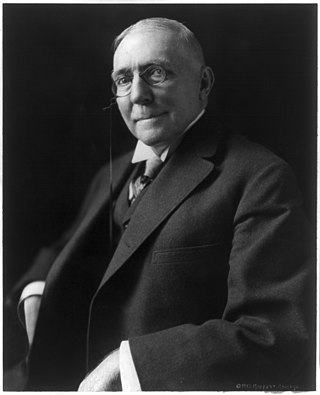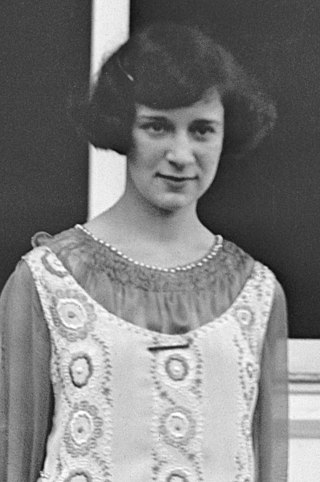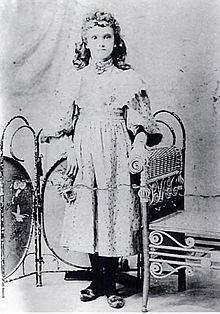"Twinkle, Twinkle, Little Star" is an English lullaby. The lyrics are from an early-19th-century English poem written by Jane Taylor, "The Star". The poem, which is in couplet form, was first published in 1806 in Rhymes for the Nursery, a collection of poems by Taylor and her sister Ann. It is now sung to the tune of the French melody "Ah! vous dirai-je, maman", which was first published in 1761 and later arranged by several composers, including Mozart with Twelve Variations on "Ah vous dirai-je, Maman". The English lyrics have five stanzas, although only the first is widely known. The song is in the public domain.

Little Orphan Annie was a daily American comic strip created by Harold Gray and syndicated by the Tribune Media Services. The strip took its name from the 1885 poem "Little Orphant Annie" by James Whitcomb Riley, and it made its debut on August 5, 1924, in the New York Daily News.

Marguerite Vivian Young was an American novelist and academic. She is best known for her novel Miss MacIntosh, My Darling. In her later years, she was known for teaching creative writing and as a mentor to young authors. "She was a respected literary figure as well as a cherished Greenwich Village eccentric." During her lifetime, Young wrote two books of poetry, two historical studies, one collection of short stories, one novel, and one collection of essays.

James Whitcomb Riley was an American writer, poet, and best-selling author. During his lifetime he was known as the "Hoosier Poet" and "Children's Poet" for his dialect works and his children's poetry. His poems tend to be humorous or sentimental. Of the approximately 1,000 poems Riley wrote, the majority are in dialect. His famous works include "Little Orphant Annie" and "The Raggedy Man".

Raggedy Ann is a character created by American writer Johnny Gruelle (1880–1938) that appeared in a series of books he wrote and illustrated for young children. Raggedy Ann is a rag doll with red yarn for hair and a triangle nose. The character was created in 1915, as a doll, and was introduced to the public in the 1918 book Raggedy Ann Stories. When a doll was marketed with the book, the concept had great success. A sequel, Raggedy Andy Stories (1920), introduced the character of her brother, Raggedy Andy. Further characters such as Beloved Belindy, a black mammy doll, were featured as dolls and characters in books.

John Barton Gruelle was an American artist, political cartoonist, children's book and comics author, illustrator, and storyteller. He is best known as the creator of Raggedy Ann and Raggedy Andy dolls and as the author/illustrator of dozens of books. He also created the Beloved Belindy doll. Gruelle also contributed cartoons and illustrations to at least ten newspapers, four major news syndicates, and more than a dozen national magazines. He was the son of Hoosier Group painter Richard Gruelle.
The Bobbs-Merrill Company was a book publisher located in Indianapolis, Indiana.

Sally Emery Hamlin was an American child actor, pianist, and recording artist.
Richard Buckner Gruelle was an American Impressionist painter, illustrator, and author, who is best known as one of the five Hoosier Group artists. Gruelle's masterwork is The Canal—Morning Effect (1894), a painting of the Indianapolis, Indiana skyline, but he is also known for his watercolors and marine landscapes of the Gloucester, Massachusetts, area. In 1891 Indiana poet James Whitcomb Riley commissioned Gruelle to illustrate two of his more notable poems, "When the Frost is on the Punkin'" and "The Old Swimmin' Hole," which were published in Neighborly Poems (1891). Gruelle is also the author of Notes, Critical and Biographical: Collection of W. T. Walters (1895), which provides a detailed description of Baltimore industrialist William Thompson Walters's extensive art collection.

The James Whitcomb Riley Museum Home, one of two homes known as the James Whitcomb Riley House on the National Register of Historic Places, is a historic building in the Lockerbie Square Historic District of Indianapolis, Indiana. It was named a National Historic Landmark in 1962 for its association with poet James Whitcomb Riley (1849-1916), known as the "Hoosier poet".

The Riley Birthplace and Museum, one of two homes called the James Whitcomb Riley House on the National Register of Historic Places, is located at 250 West Main Street in Greenfield, Indiana, twenty miles (32 km) east of downtown Indianapolis.
"Shortnin' Bread" is an American folk song dating back at least to 1900, when James Whitcomb Riley published it as a poem. While there is speculation that Riley may have based his poem on an earlier African-American plantation song, no definitive evidence of such an origin has yet been uncovered. A "collected" version of the song was published by E. C. Perrow in 1915. It is song number 4209 in the Roud Folk Song Index.

Diane Stanley is an American children's author and illustrator.
"All in the golden afternoon" is the preface poem in Lewis Carroll's 1865 book Alice's Adventures in Wonderland. The introductory poem recalls the afternoon that he improvised the story about Alice in Wonderland while on a boat trip from Oxford to Godstow, for the benefit of the three Liddell sisters: Lorina Charlotte, Alice Pleasance, and Edith Mary. Alice gave her name to Carroll's main character.

Ethel Franklin Betts Bains was an American illustrator primarily of children's books during the golden age of American illustration in the late 19th and early 20th centuries.

The Golden Age of Indiana Literature is a period from 1880 to 1920 when many nationally and internationally acclaimed literary works were created by natives of the state of Indiana. During this time, many of the United States' most popular authors came from Indiana. Maurice Thompson, George Ade, Booth Tarkington, Theodore Dreiser, Edward Eggleston, Frank McKinney Hubbard, George Barr McCutcheon, Meredith Nicholson, Gene Stratton Porter, Lew Wallace, and James Whitcomb Riley were foremost among the Hoosier authors.
The Indianapolis Journal was a newspaper published in Indianapolis, Indiana, during the nineteenth and early twentieth centuries. The paper published daily editions every evening except on Sundays, when it published a morning edition.

Mary Hartwell Catherwood was an American writer of popular historical romances, short stories, and poetry. Early in her career she published under her birth name, Mary Hartwell, and under the pseudonym Lewtrah. She was known for setting her works in the Midwest, for a strong interest in American dialects, and for bringing a high standard of historical accuracy to the period detail of her novels.

Little Orphant Annie is a 1918 American silent drama film directed by Colin Campbell and stars Colleen Moore, in her first leading role, as the title character. The film is based on James Whitcomb Riley's popular 1885 poem of the same title. Riley also appears in the film.
Margaret B. Hoberg Turrell was an American composer and organist who published her music under the name Margaret Hoberg. She was also a philanthropist who co-founded the Turrell Fund with her husband.
















